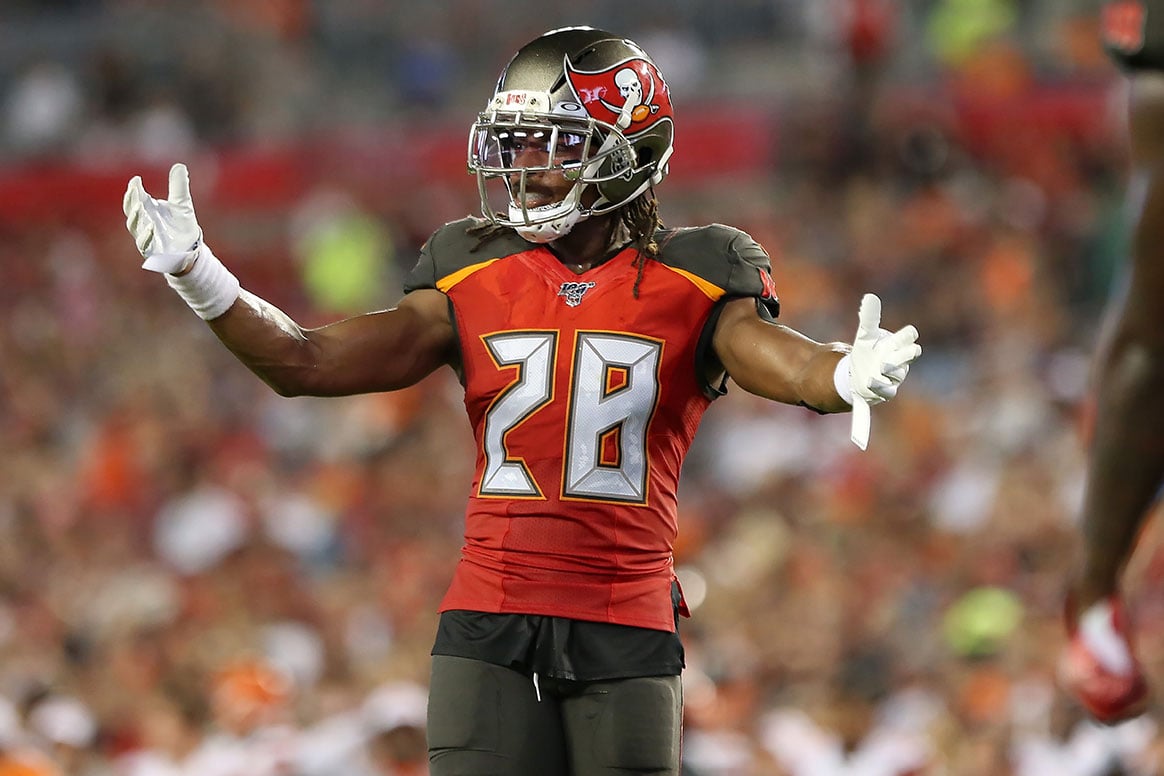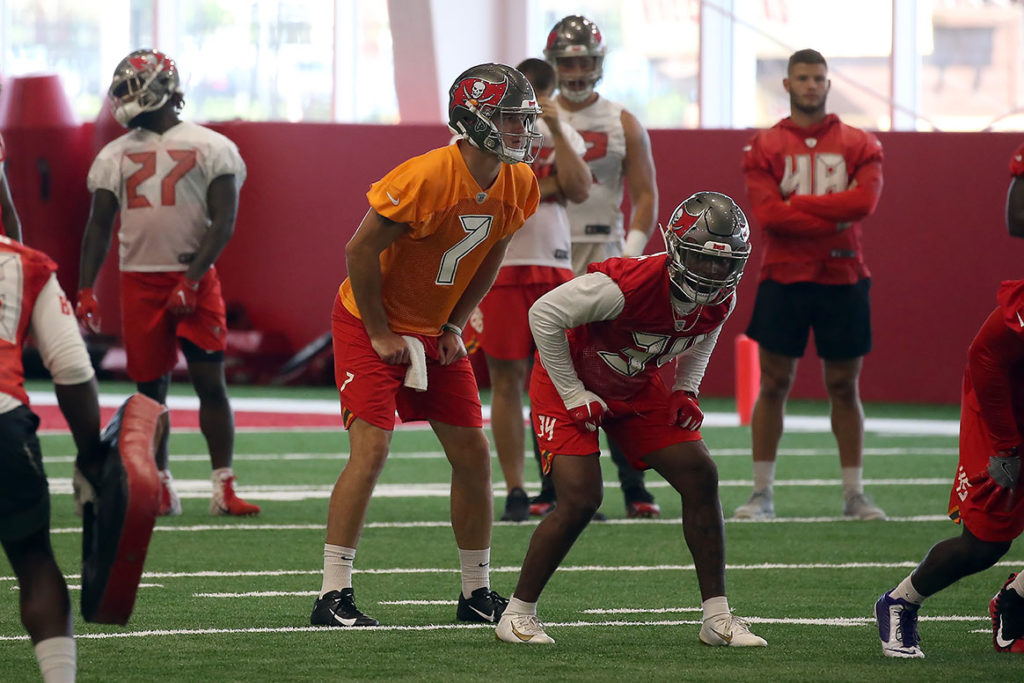Cover 3 is a weekly feature column written by PewterReport.com’s Tampa Bay Bucs beat writer Trevor Sikkema published every Tuesday. The column, as its name suggests, comes in three phases: a statistical observation, an in-depth film breakdown, and a “this or that” segment where the writer asks the reader to chose between two options.
Sikkema’s Stat of the Week
Three years ago when the Buccaneers were sitting on the worst pass defense in the NFL, we thought all their problems stemmed from their defensive coordinator. Mike Smith, who was a former successful head coach and one of the highest paid coordinators in the NFL, could not seem to stop a nose bleed when it came to the passing game. During the 2017 campaign, the Bucs were dead last in yards yielded through the air, giving up more than 4,100 passing yards. Things didn’t get much better to start the 2018 season, as Tampa remained near the bottom of the list in nearly every pass defense category.
Week-in and week-out, we were baffled by the defensive strategies we saw Smith deploy. Cornerbacks playing far off their man in soft zone coverage, safeties always playing in exclusively two-high looks. There was no aggressiveness to what they did. There was no pressure. They just sat back on their heels, kept everything in front of them and didn’t take chances. Why?
We blamed Smith.
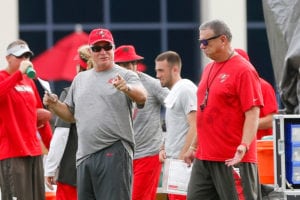
Former Bucs DCs Mike Smith and Mark Duffner – Photo by: Cliff Welch/PR
Smith was fired after Week 6 in 2018 following his defense giving up 112 points in a span of just three games (while having the worst ranked pass defense in the NFL). When Smith was relieved, linebackers coach Mark Duffner took over. When he did, there was a bit of a spark. The Bucs players seemed to react positively to the new man in charge – or at least just a new voice calling the shots. After watching Smith play such passive coverage for two and half years, it sounded like we would be getting something different from Duffner.
“I believe our approach has always been we play defense as aggressively as we possibly can,” Duffner said. “That doesn’t define meaning necessarily all blitz or pressure. That means that you play hard, that you play physical, you play smart – all those words kind of go into that word, ‘aggressive.’ You can play aggressive coverage and be in zone defense. You can play aggressive run defense and not be in a pressure situation, so I think aggressive and physical is what we’ve got to be on defense. Defense has no room for being soft.”
Finally, some attitude on the defensive side of the ball.
This is what we were waiting for. And for a while it seemed a bit different. But as the year went on, the Bucs defense slowly regressed back to the poor pass coverage unit they were before. Maybe not as bad, but it wasn’t what anyone would call good. Tampa once again finished the 2018 season giving up more than 4,100 passing yards.
For the 2019 season, Tampa Bay cleaned house with regards to its coaching staff. The team brought in Bruce Arians to be the Bucs’ head coach, and with him came a staff with a ton of experience. The biggest fish in that catch was defensive coordinator Todd Bowles. Bowles was the defensive coordinator for Arians in Arizona for two seasons before earning the New York Jets head coaching job. His presence in Tampa was supposed to bring in a new attitude, philosophy and production for a defense that hasn’t boasted that side of the ball since its days under Monte Kiffin.
In Week 1 the Bucs only gave up 166 passing yards and cornerback Vernon Hargreaves III even got a pick-6 to wrap it with a bow. In Week 2 Tampa Bay gave up 330 passing yards to Cam Newton and the Panthers, but still came away with a 20-14 win, so we didn’t really question the pass coverage that much.
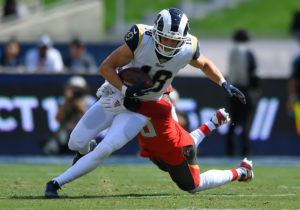
Rams WR Cooper Kupp and Bucs CB M.J. Stewart – Photo by: Getty Images
In Week 3 things began unravel in a way we couldn’t ignore, as New York Giants rookie Daniel Jones passed for 336 yards to wide open targets on their way to beating the Bucs, 32-31, at Raymond James. In Week 4, the Bucs gave up 517 passing yards to Jared Goff, but the team once again came away victorious with a 55-40 triumph, and the main storyline was elsewhere.
Finally, this past week in New Orleans, the Saints, led by backup Teddy Bridgewater, threw for 314 yards and four passing touchdowns on their way to a 31-24 victory.
Though sitting at 2-3 isn’t he worst, the problems in the Bucs secondary cannot be ignore anymore, and the root of their problems are getting more and more revealed. Even their head coach agreed.
“We weren’t [physical] today,” Arians said after the loss to the Saints.”We have been at times, but we still are too soft. We’re too soft. I don’t know any other way to put it. When we’re in press man … Now, we’ve got some guys that are getting after it but we’ve got some guys that are just soft.”
Is there anything more demoralizing for a defensive player than being called soft? If there is, I can’t think of one, especially if it’s true.
After three defensive coordinators, two head coaches and three draft cycles gone by, the direction to point the finger at is now in just two directions: the players and the man who brought them here.
There has never been an NFL defense that has ever given up 5,000 passing yards in a single season – although Tampa Bay came close in 2012 with 4,758 yards, which was a dubious league record until the New York Giants broke it in 2015 with 4,783 yards surrendered. Five games in and the Buccaneers are on pace to do that.
Tampa Bay’s 1,618 total passing yards given up and 323.6 passing yards yielded per game are by far the most in the league. In previous seasons the Bucs and the fans were able to blame it on a less talented defensive line, which was true, at the time. But now the Bucs have the NFL’s sack leader in Shaq Barrett on the edge and three other productive players around him. They still have one of the best outside linebackers in the NFL in Lavonte David, and don’t even try to tell me Devin White’s presence as a rookie would mean this much.
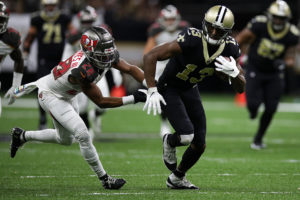
Bucs CB Vernon Hargreaves III – Photo by: Getty Images
No. It’s not the scheme. It’s not the coaches. It’s not the players around them.
It’s the cornerbacks.
Vernon Hargreaves III was drafted No. 11 overall to be this team’s CB1 someday. We’re in Year Four of Hargreaves in the NFL and he has yet to become that.
In his first two seasons, Hargreaves struggled mightily. He was the most targeted cornerback in the NFL during his rookie campaign, giving up 1,069 passing yards and allowing 70 percent of the passes thrown on his assignments to be caught. He was barely better his second year, and was playing exclusively in the slot before getting hurt during his third season.
After missing 15 and half games in 2018 after suffering a season-ending shoulder injury in the season-opening win at New Orleans, Hargreaves has been given the starting outside cornerback spot this year. I say given because he has not earned it. The Bucs just don’t have anyone else to give it to.
Hargreaves has played well – or should I just say better? – at times, but he is still not a CB1. Games like the one he had against Carolina, Los Angeles and certainly in New Orleans prove that as he allows too many passes to be caught against him.
Hargreaves may just be what he is at this point. A decent-to-good starting cornerback, which is fine, but it’s not what this team needs him to be. It’s not what Tampa Bay thought when it selected him so high in the draft to be; he’s just not a CB1.
Hargreaves has not shown he can consistently come in with a shutdown mentality every week. Is it in there? I don’t know, but right now we haven’t seen enough of it. He seems to be a CB2-type being asked to play a CB1 role. It’s not going well.
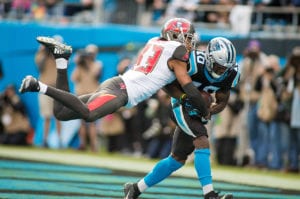
Bucs WR Carlton Davis and Panthers WR Chris Samuels – Photo by: Mary Holt/PR
The Bucs drafted Calton Davis at the top of the second round in 2018 to match up with players like Julio Jones and Michael Thomas in this division. At 6-foot-1, 210 pounds, Davis is in the 80th and 90th percentile for size when it comes to cornerbacks in the NFL.
The problem is Davis’ 4.53 40-yard dash is in the 37th percentile. He has the length, but sometimes he just can’t keep up. And even more worrisome than that, Davis doesn’t create turnovers. In fact, Davis hasn’t recorded an interception since September of 2017 when he was at Auburn, and before that his previous interception was 2015 as a freshman. He’s long and he’s physical, but he can’t always run with the top dogs and he doesn’t generate turnovers. That’s a CB2 player with limitations. Not a great starting point.
In the slot, M.J. Stewart is not getting beat nearly as much as he was his first season – which was a lot – since this defensive scheme is allowing him to be more physical with guys. But Stewart, who was drafted to potentially be converted to safety, also has athletic limitations.
New rookie Sean Murphy-Bunting, though he got his first interception this past weekend, has not looked like he’s ready for Sundays and the Bucs have tried him inside at nickel and outside at cornerback. Fellow rookie Jamel Dean is the one guy who I understand could have a role on this team. He’s got Davis’ size at 6-foot-1, 210 pounds, but he’s very fast with 4.3 speed. He just hasn’t seen much playing time yet due to some injuries. Perhaps that’s coming.
So if you look at the Bucs’ cornerback position and all the draft picks they’ve poured into it, it seems as though they’re each trying to play each guy at a level higher than they really should be. And that ultimately comes back to the man who drafted them.
General manager Jason Licht has certainly tried to fix the Bucs secondary woes. He’s invested nine picks in the last four drafts into either cornerbacks or safety. The result is what we saw on Sunday against New Orleans, and Los Angeles, and Carolina, and the last two seasons.
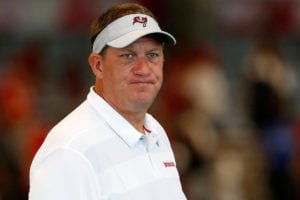
Bucs GM Jason Licht – Photo by: Cliff Welch/PR
The Bucs secondary, in the words of their head coach, is soft. They don’t have the ability at CB1 to shut down a team’s best receiver. They don’t have the mentality at CB2 to get takeaways, and they don’t have the mentality to be aggressive enough overall. That’s not necessarily a coaching problem; it can’t be anymore. That’s a scouting and drafting problem.
I don’t want to say that this team’s corners are what they are with no hope of things getting better because we see around the NFL all the time that that is not true. However, right now it’s a group whose play has warranted the word “soft” – and hopefully that’s a wake up call. I’m not saying that’s all the secondary will ever be, but something need to change. A move needs to be made, among this group and even outside of it.
I’ll tell you what those moves are on the next two pages.
Trevor Sikkema is the Tampa Bay Buccaneers beat reporter and NFL Draft analyst for PewterReport.com. Sikkema, an alumnus of the University of Florida, has covered both college and professional football for much of his career. As a native of the Sunshine State, when he's not buried in social media, Sikkema can be found out and active, attempting to be the best athlete he never was. Sikkema can be reached at: [email protected]

